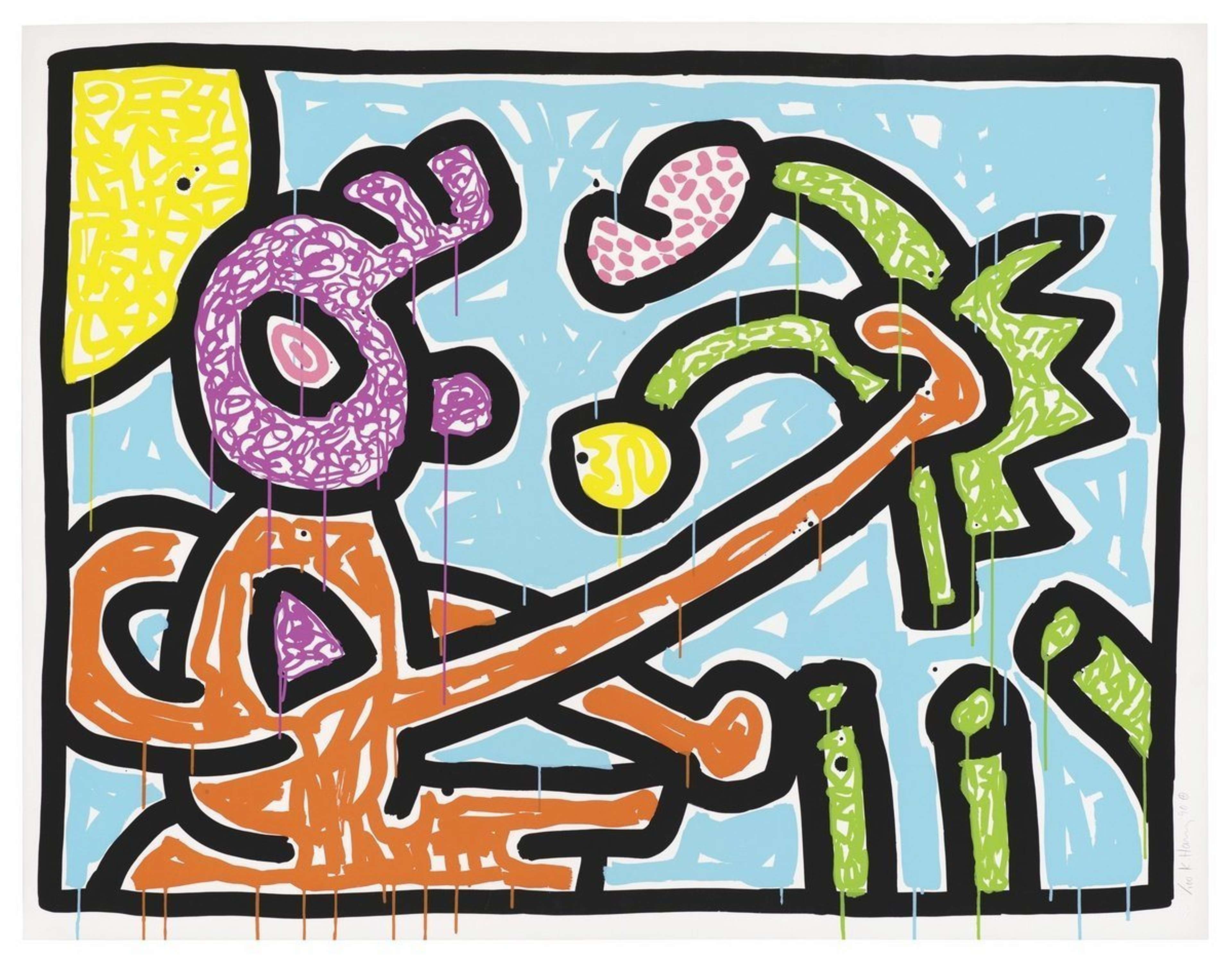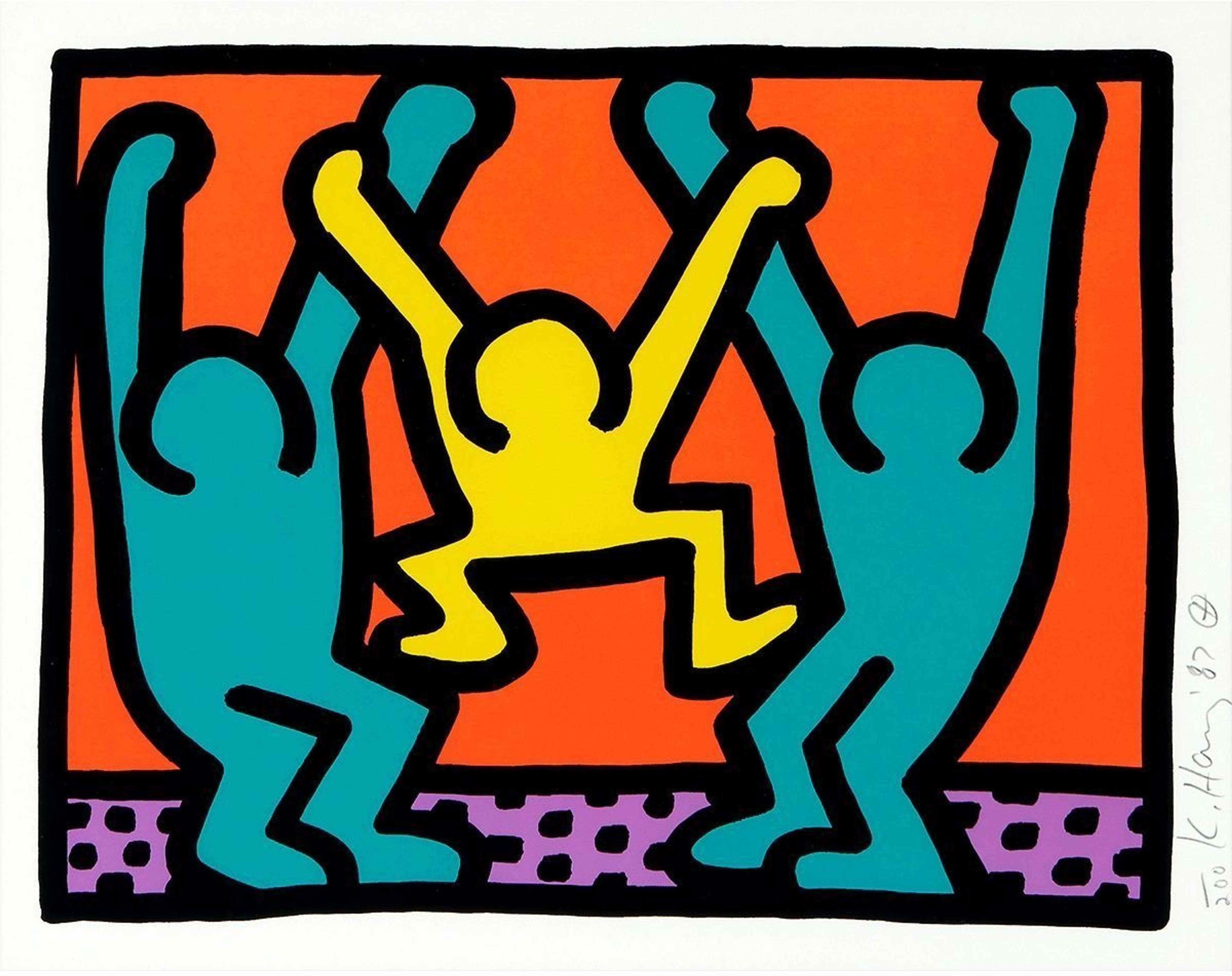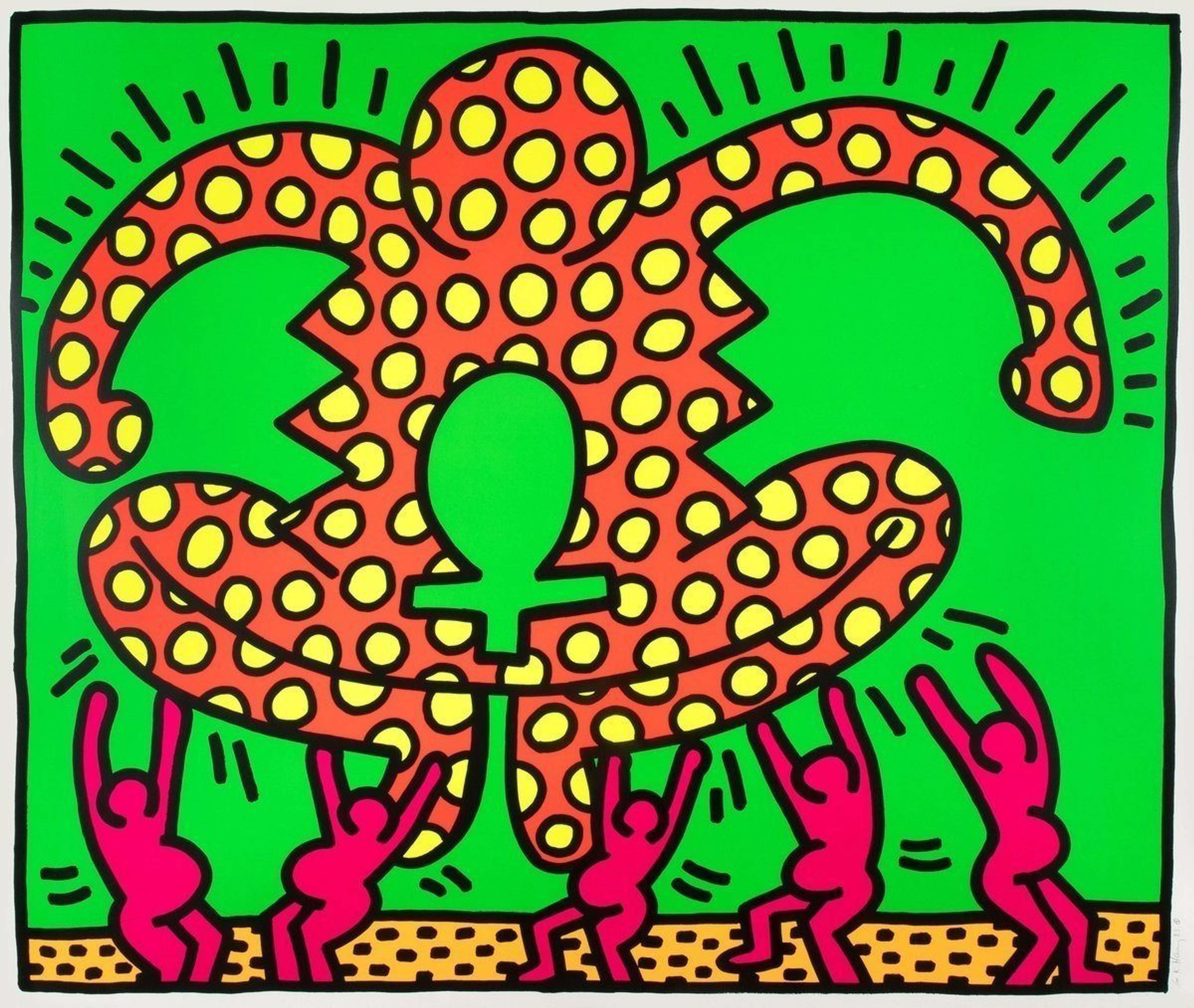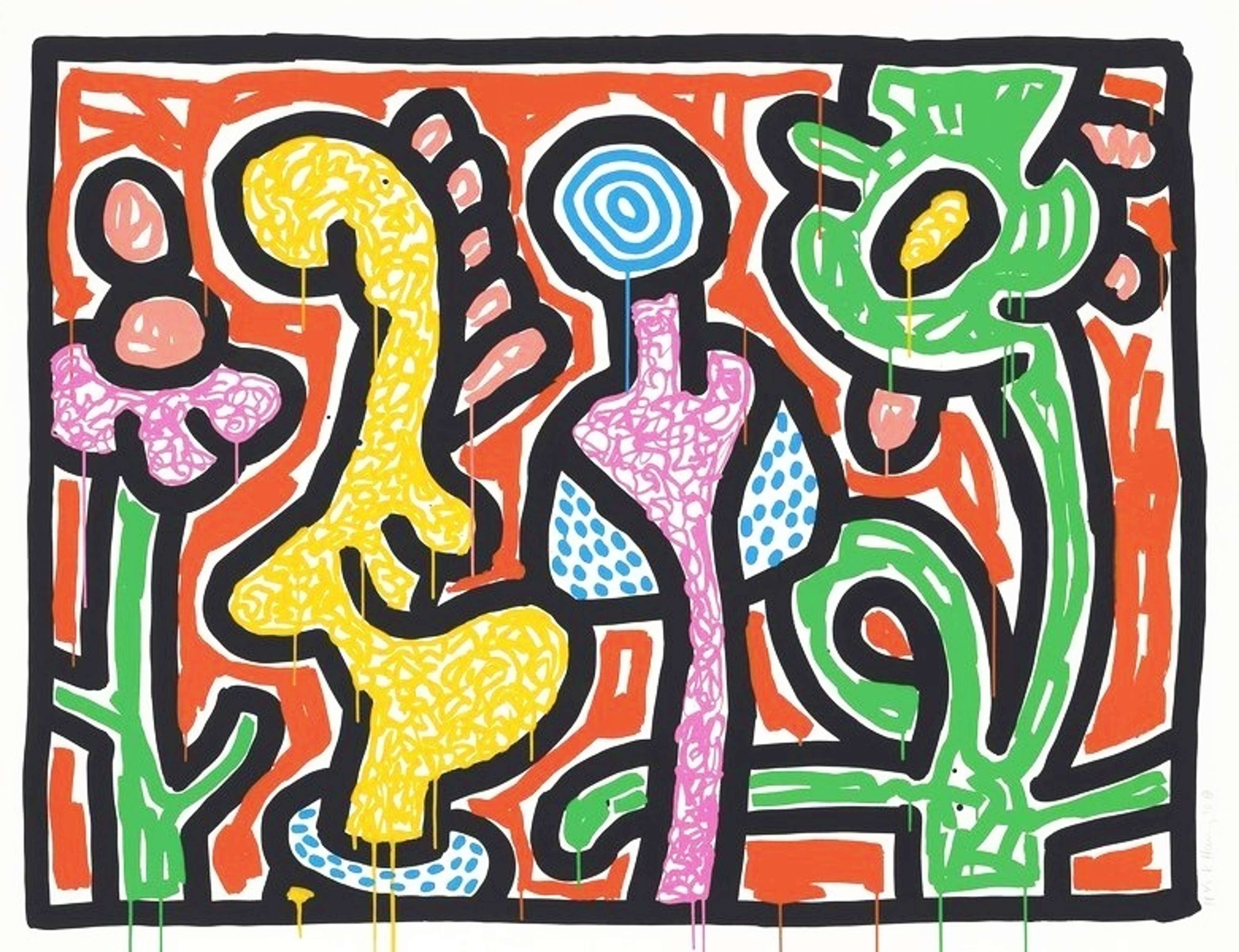 Flowers IV © Keith Haring 1990
Flowers IV © Keith Haring 1990
Interested in buying or selling
Keith Haring?

Keith Haring
250 works
Keith Haring's Flowers series was created mere months before his untimely death from AIDS in 1990. The series diverges in style from his earlier oeuvre, and speaks to the impermanence and fleetingness of time in the face of death.
The series was created months before Haring's untimely death in 1990.
 Flowers I © Keith Haring 1990
Flowers I © Keith Haring 1990Printed in the months leading to his untimely death from AIDS in 1990, Haring's Flowers series carries a weighted sense of urgency. In his sprawling application of colour and rapidly delineated figures, we witness the artist working against the inevitable force of time. In Flowers I, the flowers appear to have been plucked by a strange creature. The flowers wilt in its grip, perhaps alluding to Haring's coming to terms with his fate.
Haring's Flowers reveal his suffering from AIDS towards the end of his life.
 Flowers II © Keith Haring 1990
Flowers II © Keith Haring 1990Unlike his hopeful Dancing Flower, Haring's 1990 Flowers series is much more ambiguous and emotionally loaded. Flowers II, for example, depicts three human-like flower stems trapped by a chain reaching across the centre of the composition. The flowers also appear to grow phallic limbs, making the chain an even more threatening force and alluding to the physical and mental pain Haring faced towards the end of his life.
The series appropriates the historical genre of vanitas to convey Haring's own mortality.
 Flowers V © Keith Haring 1990
Flowers V © Keith Haring 1990In the long-standing history of art, flowers have been used as a symbol for the richness and beauty of life, as well as the fleetingness and fragility of it. From the 16th century, flowers became an integral component of vanitas painting, which united symbolic objects to illustrate mankind's mortality. Haring's focus on the subject months before his death might, therefore, signal his reflection on the impermanence of his own short life.
The series reveals the influence of Abstract Expressionism and Jean-Michel Basquiat.
 Ernok © Jean-Michel Basquiat 2001
Ernok © Jean-Michel Basquiat 2001In his rapid and expressive application of coloured inks during the printing process, Haring's Flowers convey the ideals of Abstract Expressionism. The works appear spontaneous, or automatic, adding to the sense of urgency in the series. Haring's unconstrained mark-making, and a less precise handling of figuration, especially calls to mind the work of his friend and fellow artist Jean-Michel Basquiat. Basquiat had died two years previously, which perhaps led Haring to turn to him during the final months of his own life.
Haring's Flowers diverges in style from his earlier work.
 Pop Shop I, Plate IV © Keith Haring 1987
Pop Shop I, Plate IV © Keith Haring 1987Previously, Haring's oeuvre had been underscored by clearly delineated figures and solid blocks of bold colour. It was this simple approach to the printing plate and process which made Haring's work so easily readable across a wide viewership. However, in his late Flowers series the colour is almost scrawled onto the printing plate like a pen. Likewise, if it weren't for the title of the series, the subject matter of these prints might not be so easily legible.
The phallic form of Haring's Flowers alludes to his reflection on HIV/AIDS.
 Flowers III © Keith Haring 1990
Flowers III © Keith Haring 1990Across several of the prints in the series, Haring's so-called Flowers assume a phallic form. Many have interpreted this approach to the flora as Haring's frank acceptance of his fate and a reflection on his own mortality.
The coloured dots in the series are Haring's motif for the othering of people with HIV/AIDS.
 Fertility 5 © Keith Haring 1983
Fertility 5 © Keith Haring 1983Throughout the height of his artistic career, Haring frequently used his art in the service of activism. In particular, Haring often represented the injustices facing LGBTQ+ communities in the 1980s. This was a decade underscored by the relentless threat of HIV/AIDS, and Haring campaigned to destigmatise the disease until his death from it in 1990.
The series is characterised by a more visceral and hurried method of printing.
 Flowers IV © Keith Haring 1990
Flowers IV © Keith Haring 1990Unlike the simple and clear-cut style of earlier series like Pop Shop, Flowers has a much more emotive and unconstrained visual appeal. During the printing process, Haring applied larger quantities of screen printing ink to his paper, allowing it to drip down the composition. The trickles of paint add to the sense of urgency in the series, and allude to Haring's desperation to produce as much as possible before his death.
The series is testament to Haring's ability to convey serious subject matter through child-like imagery.
 Pyramid (blue) © Keith Haring 1989
Pyramid (blue) © Keith Haring 1989Throughout his artistic career, Haring created characters fitting of children's stories to illustrate some of the most pressing socio-political issues of his time. By creating his own iconography, Haring used seemingly-naive imagery to convey universally readable messages. As the Flowers series attests, there is always more to Haring's work than meets the eye.
Haring continued producing art until his death.
 The Blueprint Drawings 11 © Keith Haring 1990
The Blueprint Drawings 11 © Keith Haring 1990Though Flowers was produced mere months before his death, it was not the last print series created by Haring. The Blueprint Drawings is generally regarded as his last comprehensive portfolio and, like Flowers, is Haring's final appeal for HIV/AIDS visibility before the disease claimed his own life.
